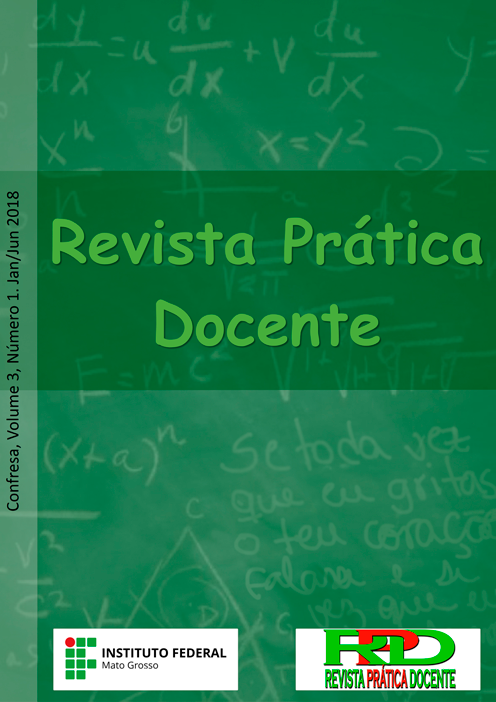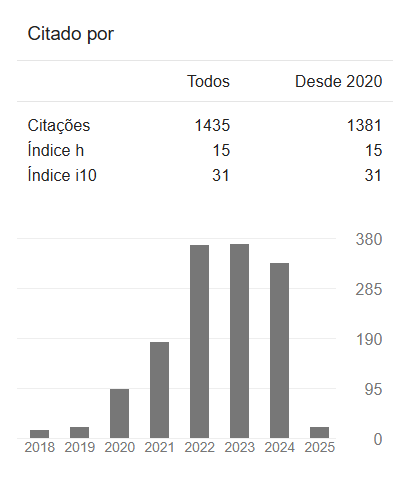MIME GAME FOR THE TEACHING OF HEAT PROPAGATION: CONDUCTION, CONVECTION AND IRRADIATION
DOI:
10.23926/RPD.2526-2149.2018.v3.n1.p158-170.id142Keywords:
Physics teaching, Heat propagation, MimicryAbstract
The work presents results for the use of differentiated didactic resources for the teaching of physics, with the objective of facilitate the teaching and learning process. The proposed class includes the theoretical presentation of the contents, specifically about sensible heat, latent heat and the processes of heat transmission: conduction, convection and irradiation. In addition, the methodology includes the use of a low-cost experiment, the resolution of exercises, the execution of the game "Gesturing the Physics", and at end, the application of the investigative questionnaire on the resource used. The proposed dynamic is mimicry, inspired in the game "Image and Action", in which one of the players of the team must to mimic for the remainder, from physical phenomena about everyday situations. The rest of the group should discover the situation represented and what is the heat transfer process involved. The scholarship holders from Institutional Program for Initiation to Teaching of the physics (PIBID/Physics) from Federal University of Acre (UFAC) ministered class to the students from 3rd year of high school in a public school in Rio Branco-AC, inside the extension project “Sciences in the School: Experimentation and Theory”. The results show that the use of the proposed didactic sequence stimulated students to understand and fixation of content in an easy and fun way. In addition, the proposed dynamics revealed to be a promising resource for physics teaching.
Downloads
Metrics
References
BAIÃO, L. P. M.; CUNHA, R. G. Doenças e/ou disfunções ocupacionais no meio docente: uma revisão de literatura. Revista Formação@Docente, Belo Horizonte, v. 5, N. 1, jan/jun 2013. Disponível em: <http://www3.izabelahendrix.edu.br/ojs/index.php/fdc/article/view/344/0>. Acessado em 03 mar. 2018. DOI: https://doi.org/10.15601/2237-0587/fd.v5n1p6-21
BEZERRA, D. P.; GOMES, E. C. S.; MELO, E. S. N.; SOUZA, T. C. A evolução do ensino da física – perspectiva docente. Scientia Plena, v. 5, p. 094401-1 - 094401-8, 2009. Disponível em: <https://scientiaplena.emnuvens.com.br/sp/article/viewFile/672/342>. Acessado em 03 mar. 2018.
BRASIL. PCN+: Orientações educacionais complementares aos Parâmetros Curriculares Nacionais, Ciências da Natureza, Matemática e suas Tecnologias. Brasília: Ministério da Educação e Cultura, 2002.
CARUSO, F.; CARVALHO, M.; SILVEIRA, M. C. Uma proposta de ensino e divulgação de ciências através dos quadrinhos. Ciência & Sociedade, Rio de Janeiro, v. 8, 2002. Disponível em: <http://cbpfindex.cbpf.br/publication_pdfs/cs00802.2006_12_08_10_29_32.pdf>. Acessado em 03 mar. 2018.
CARVALHO, A. M. P.; PÉREZ, D. G.; Formação de Professores de Ciências: tendências e inovações. São Paulo: Cortez Editora, 9° Ed., 2009.
MEDINA, M. O teatro como ferramenta de aprendizagem da física e de problematização da natureza da ciência. Cad. Bras. Ens. Fís., v. 27, n. 2, p. 313-333, ago. 2010. Disponível em: <https://periodicos.ufsc.br/index.php/fisica/article/view/2175-7941.2010v27n2p313>. Acessado em 03 mar. 2018.
MORAES, J. U. P. A visão dos alunos sobre o ensino de física: um estudo de caso. SCIENTIA PLENA, v. 5, N. 11, p. 114809-1 - 114809-7, 2009. Disponível em: <https://www.scientiaplena.org.br/sp/article/view/736>. Acessado em 03 mar. 2018.
MOURA, M. O. (Org.) A série busca no jogo: do lúdico na matemática.14 Ed. São Paulo: Editora Ática, 1988.
MOYLES, J. R. Só brincar? O papel do brincar na educação infantil. Tradução: Maria Adriana Veronese. Porto Alegre: Artmed, 2002.
NAPOLITANO, M. Como usar o cinema na sala de aula. São Paulo: Contexto, 2005.
NOVAK, J. D. Uma teoria de educação. São Paulo: Pioneira, 1981. Tradução de M. A. Moreira do original A theory of education, Cornell University Press, 1977.
PEREIRA, R. F.; FUSINATO, P. A.; NEVES, M. C. D. Desenvolvendo um jogo de tabuleiro para o ensino de física. In: Encontro Nacional de Pesquisa em Educação em Ciências VII Enpec, Florianópolis, 8 de Novembro de 2009. Anais. Disponível em: <http://posgrad.fae.ufmg.br/posgrad/viienpec/pdfs/1033.pdf>. Acessado em 03 mar. 2018.
RICARDO, E. C.; FREIRE, J. C.A. A concepção dos alunos sobre a física do ensino médio: um estudo exploratório. Revista Brasileira de Ensino de Física, v. 29, n. 2, p. 251-266, 2007. Disponível em: <http://www.scielo.br/pdf/rbef/v29n2/a10v29n2.pdf >. Acessado em 03 mar. 2018. DOI: https://doi.org/10.1590/S1806-11172007000200010
ROSA, C. W.; ROSA, Á. B. Ensino da Física: tendências e desafios na prática docente. Revista Iberoamericana de Educación, v. 43, N. 1, p. 1 -12, 2007, Número especial. Disponível em: <https://rieoei.org/RIE/article/view/2343>. Acessado em 03 mar. 2018. DOI: https://doi.org/10.35362/rie4312343
ROSA, G. P.; DEPS, V. L. Desatenção do Aluno e Estratégias de Aprendizagem no Contexto Escolar. Revista Científica Interdisciplinar, Nº 4, v. 2, artigo nº 22, Outubro/Dezembro 2015. Disponível em: <http://dx.doi.org/10.17115/2358-8411/v2n4a22>. Acessado em 03 mar. 2018. DOI: https://doi.org/10.17115/2358-8411/v2n4a22
VYGOTSKY, L. S. A Formação Social da Mente. 6. ed. São Paulo: Martins Fontes Editora Ltda., 1998.
Downloads
Published
How to Cite
Issue
Section
License
Copyright (c) 2023 A Revista Prática Docente tem o direito de primeira publicação

This work is licensed under a Creative Commons Attribution-NonCommercial 4.0 International License.
Authors who publish in this journal agree to the following terms:
- Authors retain the copyright and grant the journal the right of first publication, with the paper simultaneously licensed under the Licença Creative Commons Attribution allows the sharing of the work with acknowledgment of authorship and initial publication in this journal.
- Authors are authorized to take additional contracts separately, for non-exclusive distribution of the version of the work published in this journal (e.g. publish in institutional repository or as a book chapter), with acknowledgment of authorship and initial publication in this journal.











